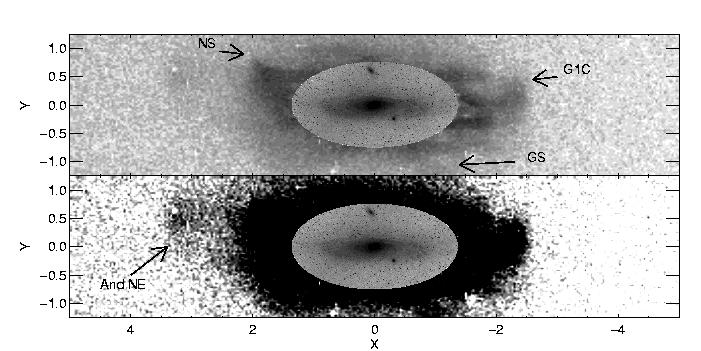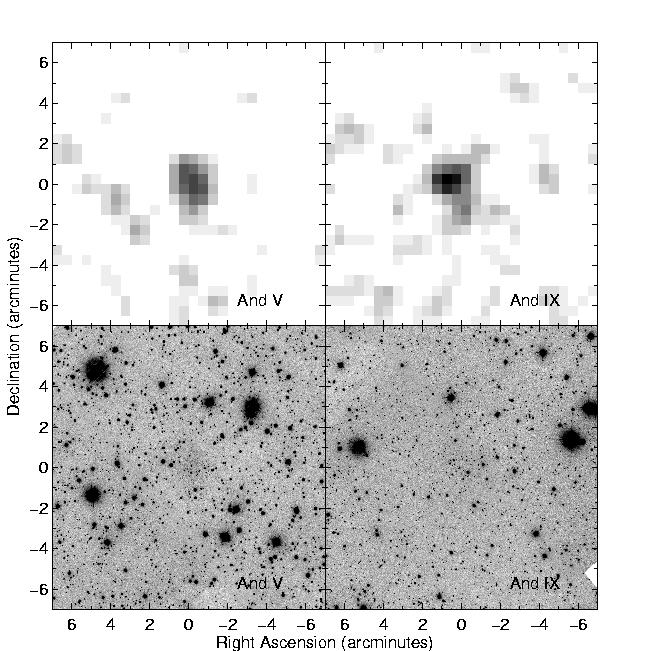| Galactic
Structure:
During of last time I also was involved
in an MPIA project to study Galactic Structure based on Sloan Digital
Sky Survey (SDSS) stellar photometry. Our research concentrates on the
following topics: (a) A study of structural parameters of
globular clusters and a search for tidal disruption. (b) A study
of structural parameters of Milky Way satellite galaxies and search for
extratidal features. (c) A search for tidal streams of disrupted
satellites in the Galactic halo and for new low surface brightness
members of the Local Group. During this period of time I have created
my own software to produce a matched-filter analysis of stellar density
data, the derivation of surface photometry parameters and the analysis
of surface brightness profiles using stellar counts. We have currently
some exciting results from studying M31 SDSS data:
(1) we found a faint, extended stellar
feature in the outer halo of M31, using a special scan from SDSS.
Though the scan is relatively shallow, it covers a very large area
along the major axis of M31, and reaches depths sufficient to detect
bright red giant stars at the distance of M31. We used these data to
estimate the feature's physical properties, such as its size and total
luminosity, and to try to determine its true nature (see SDSS
press-release:
COULD
GALACTIC FIND BE ANDROMEDA'S FOOD? SLOAN DIGITAL SKY SURVEY REVEALS
GIANT CLUMP OF STARS NEAR THE ANDROMEDA GALAXY šfor
more details).

|
M31 Stellar Substructure in the SDSS Data: Top: The spatial distribution of all stars with
21 <š i š< 22, with an inset optical image of M31 to scale. The
arrows indicate major halo substructures: the northern spur (NS), the
giant stream (GS) and the G1
clump (G1C). Anromeda NE's center is located at about (3,0.5). Bottom:
Same as (top), but with the
grayscale adjusted to emphasize faint
details. The arrow shows the position of Andromeda NE. The data in both
pa
nels have been
binned 2' x 2'. X and Y are in arcdegrees from šthe center of M31 (00:42:44.3 +41:16:08.5
J2000), along the major and minor axes, respectively.
š(From Zucker, D.B., Kniazev, A.Y. et al., New Giant Stellar Structure Near the Outer
Halo of M31: Satellite or Stream?,
2004, submitted to ApJL (astro-ph/0401098).). |
(2) we reported the discovery of a new dwarf
spheroidal satellite of M31, Andromeda IX.š Using both SDSS and public
archival data we have estimated its distance and other physical
properties, and compared these to the properties of a previously known
dwarf spheroidal companion, Andromeda V, also observed by SDSS. Based
on our measurements, Andromeda IX is the lowest surface brightness
galaxy found to date (mu_{V,0} š~ 27.0 mag/arcsec^2), and at the
distance we estimate šfrom the position of the tip of Andromeda IX's
red giant branch, (m - M)_0 ~ 24.5 (805 kpc), Andromeda IX is the
faintest galaxy as well (M(V)š ~ -8.3).

|
Andromeda V and Andromeda IX as seen by
SDSS: Top: The spatial
distribution of all SDSS stars with i > 20.5 in the fields of
Andromeda V (left) and
Andromeda IX. The data in both
panels were binned
š30" x 30" and smoothed with a
Gaussian (FWHM = 1').
Bottom: Combined g, r and i SDSS
images of Andromeda V (left) and Andromeda IX. Each panel spans 14' x 14' and is oriented
with north up and east to the
left.
|
|